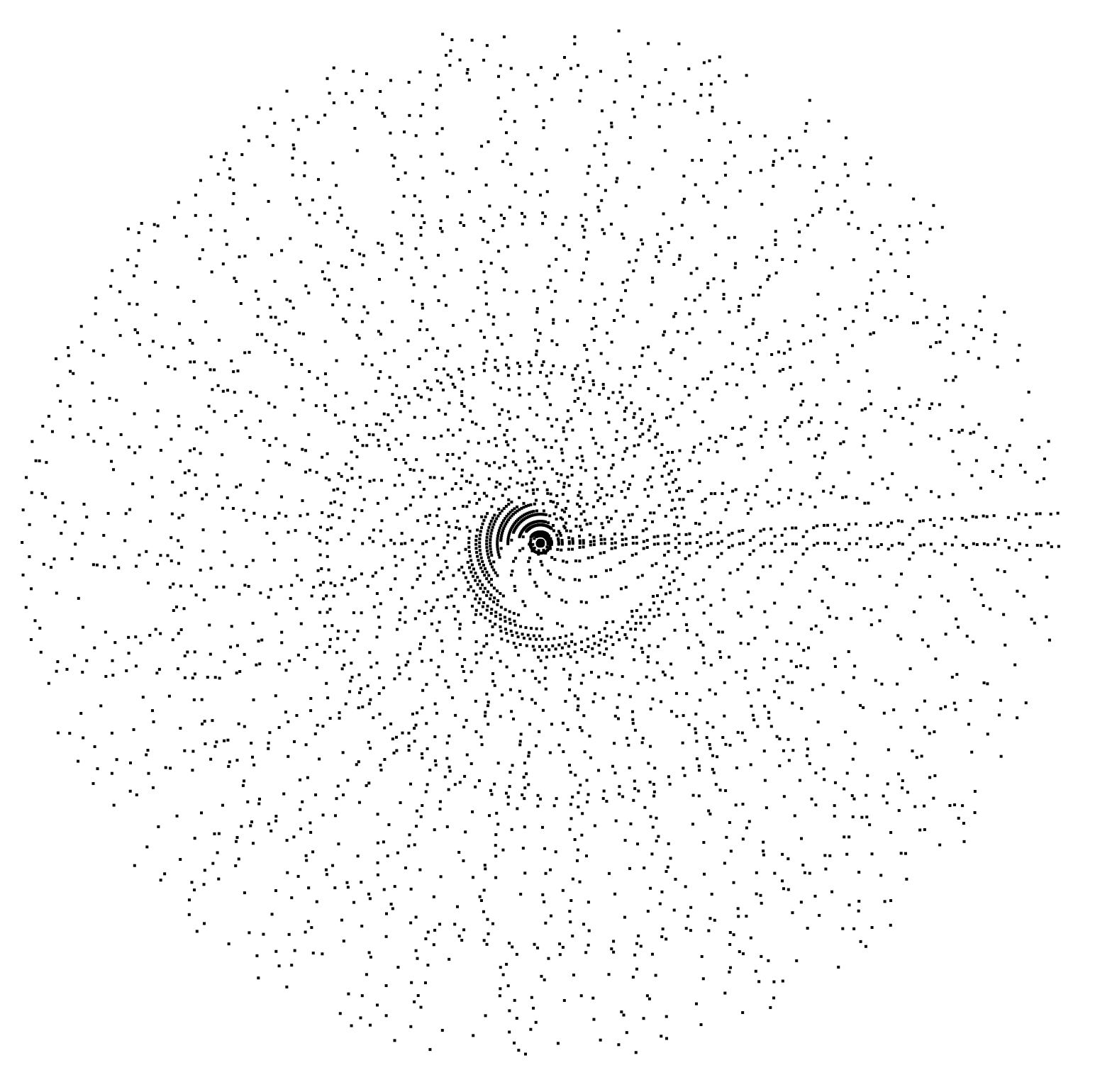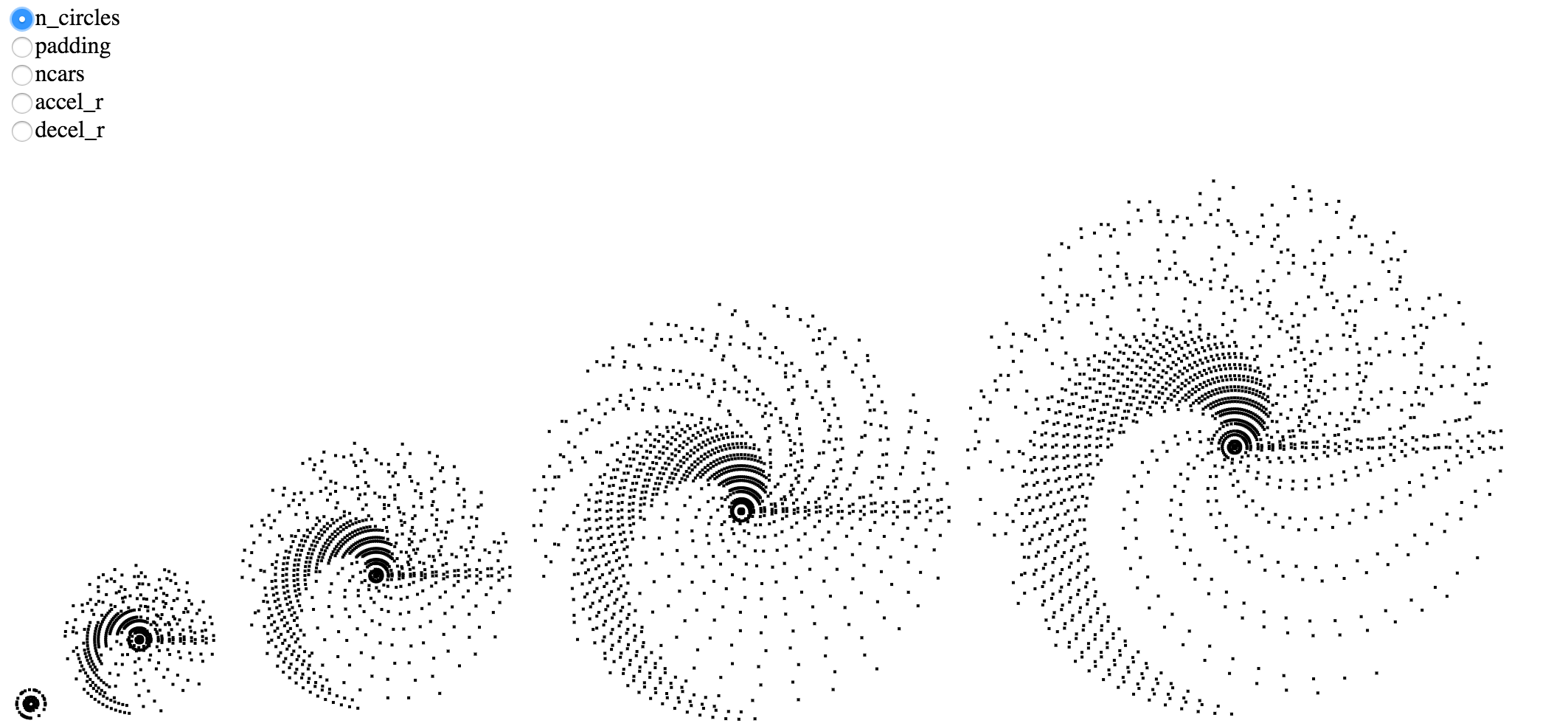Not only did Aran show up to the opening on Saturday, but that very same day he gave me a shout-out in his one-page. Needless to say I’m flattered.



Alternatively:
Time works differently in airplanes. In LA it’s 1am, but in London it’s 10am. It’s all of the times, all of the time, in some of the places, and I am in none of the places. Needless to say, I can’t fall asleep.
Simultaneously:
Toby keeps sending me the endless fetus. There’s seven people dead on a South Dakota farm. Some way’s in the distance there are seven new people born.
Finally:
After a myopic week or two, I return to my usual hyperopia. Thoughts are permitted to wander. Back to the puzzle of time.
Consequently:
I was reminded of this traffic simulation visualization, and opened it up to recall how I had been thinking about time. It occurred to me that implementing the fetus spiral would be a trivial patch, and I was curious to see how it would look. Link.

It’s pretty insane. At first, I had no idea how to read it, but at least it made good in-flight entertainment. The speed difference between the inside and outside seems somewhat severe.
To help myself figure out what the hell was going on, I made a multi-view. Link It seems like these fetal traffic circles are comparable, even without animation.
Increasing the acceleration rate un-clogs traffic jams:

but changing the parameters of the visualization does’t significantly change perception of the simulation:

Being able to compare different possibilities seems like a fundamental characteristic of the virtual, and of this thing we call Systems Thinking. It goes beyond enlargement of our frame of reference. There’s the experience of being in a car in traffic. Then, with radio-helicopters or citizen-sourced Waze, we can imagine traffic on the scale of a city—we can imagine being in a car in traffic on the I-10 or the 405. I have an intuition that the virtual "what-if” is simply not understandable through the identification that helps us to understand what it would be like if we were in traffic somewhere else. That is, I don’t think an appropriate physicalization of this model would involve sitting in a car in traffic in different scenarios. They don’t make ladders big enough for them abstractions. This is a long-winded & suddenly very fatigued way of asking: what, if anything, is the role of physical reality in systems thinking (beyond as an “end”)? I could imagine animating even more dots on a 3-d display, but I think this iteration is pixel-dense enough that it doesn’t seem like a substantive difference. Maybe a scale model? Have the dots on miniature roads, and not on whitespace? Or is systems thinking, fundamentally, about a dissociation away from the physical and into the virtual?
Your airborne virtual correspondent, whose physical reality is starting to catch up— prepare for landing,
R.M.O.
On Mar 13, 2015, at 6:38 PM, Robert M Ochshorn wrote:(ps - click and drag to take time into your own hands!)On Mar 13, 2015, at 6:22 PM, Robert M Ochshorn wrote:Friends!Since I’m in LA, I decided to check out the CDG-LA offices. What should have been a 30 minute drive took 60, and when I got to the office and complained about the traffic, of course everyone here was ready to sympathize and share their own traffic stories.I brought the VPRI archive binder and gave a clumsy demo of that in front of the epic shelves of now-digitized VHS tapes[0], and I’m excited to take this binder further. (Incidentally, and this is deserving of its own write-up, but I’m improving my computer vision chops and can now fairly reliably pick out pages from a book.) It would be fun to set up VPRI archive terminals in SF and LA that are linked in some way, which I may attempt in time for the All-Hands.But back to traffic, because it’s always back to traffic in this city. Aran showed me an in-process visualization he’s been working on, inspired by Bret’s work and leveraging this circular-road traffic simulation (is there a metaphor in there?), where he wants to show “what-if” scenarios in a traffic simulation. I was frustrated by only seeing one moment at once, or by seeing traffic abstracted from “seeing something moving slowly or not at all” to numbers that stand in for that (i.e., “velocity”), and I found myself making many of the arguments I have been developing about video. Specifically, that the human perceptual system has a lot of built-in facilities for understanding motion, but that doesn’t mean you need to be trapped in one moment. So while Aran was meeting with a student, I threw together a quick and dirty traffic simulator that shows you five minutes of behavior all at once as a time-space-multi-phase-loop (is there a name for this technique?):<Screen Shot 2015-03-13 at 6.00.27 PM.png>It’s non-interactive, though the code should support divergent what-if’s if I decide to push this any further[1]. Aran noted that my approach to “pseudo-animation”—preserve motion, while abstracting out time—was an interesting departure from the ladder. This may be worth considering in more detail. That is, my claim would be that you would understand the car better if you saw it moving along its path in all possibilities, not only the trace of its path. Bret—did you play with any small-multiple animations when you were making that?Now, back to the traffic,R.M.O.[0] VHS tapes in shelving are not un-discoverable. One title caught my eye that I hadn’t noticed leafing through hard drives or looking at thumbnails. Ironically, the title that caught my eye was Neil Postman: Informing Ourselves to Death, which is a presentation he gave at Apple. We should watch that together.[1] I can see that Rich Hickey is starting to have an influence on me already: when you “tick” the simulation forward in time, it doesn’t mutate any state, but instead returns a new system.